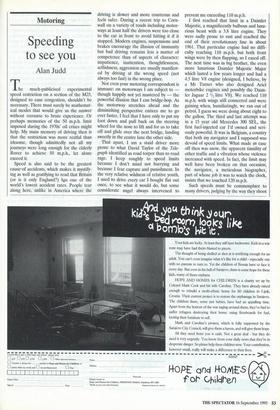Motoring
Speeding to see you
Alan Judd
The much-publicised experimental speed restriction on a section of the M25, designed to ease congestion, shouldn't be necessary. There must surely be mathemat- ical modes that would give us the answer without recourse to brute experience. Or perhaps memories of the 50 m.p.h. limit imposed during the 1970s' oil crises might help. My main memory of driving then is that the restriction was more restful than irksome, though admittedly not all my journeys were long enough for the elderly Rover to achieve 50 m.p.h., let alone exceed it.
Speed is also said to be the greatest cause' of accidents, which makes it mystify- ing as well as gratifying to read that Britain (or is it only England?) has one of the world's lowest accident rates. People tear along here, unlike in America where the driving is slower and more courteous and feels safer. During a recent trip to Corn- wall on a variety of roads including motor- ways at least half the drivers were too close to the car in front to avoid hitting it if it stopped. Modern engines, suspensions and brakes encourage the illusion of immunity but bad driving remains less a matter of competence than of aspects of character: impatience, inattention, thoughtlessness, selfishness, aggression are usually manifest- ed by driving at the wrong speed (not always too fast) in the wrong place.
Not even your motoring correspondent is immune: on motorways I am subject to though happily not yet mastered by — the powerful illusion that I can bridge-hop. As the motorway stretches ahead and the diminishing perspective entices me to go ever faster, I feel that I have only to put my foot down and pull back on the steering wheel for the nose to lift and for us to take off and glide over the next bridge, landing sweetly in the centre lane the other side.
That apart, I am a staid driver more prone to what David Taylor of the Tele- graph identified as road torpor than to road rage. I keep roughly to speed limits because I don't mind not hurrying and because I fear capture and punishment. In the very relative wildness of relative youth, I used to drive every car I bought flat out once, to see what it would do, but some considerate angel always intervened to prevent me exceeding 110 m.p.h.
I first reached that limit in a Daimler Majestic, a magnificently bulbous and luxu- rious beast with a 3.8 litre engine. They were sadly prone to rust and reached the end of their revolutionary line in about 1961. That particular engine had no diffi- culty reaching 110 m.p.h. but both front wings were by then flapping, so I eased off. The next time was in big brother, the even more luxurious Daimler Majestic Major which lasted a few years longer and had a 4.5 litre V8 engine (designed, I believe, by a Mr Turner who also designed Ariel motorbike engines and possibly the Daim- ler Jaguar 2 1/2 litre V8). We reached 110 m.p.h. with wings still connected and were gaining when, humiliatingly, we ran out of petrol. I guess we were doing about eight to the gallon. The third and last attempt was in a 15 year old Mercedes 300 SEL, the first fuel-injected car I'd owned and seri- ously powerful. It was in Belgium, a country that both my navigator and I supposed was devoid of speed limits. What made us ease off then was snow, the apparent timidity of other traffic and a vibration whose violence increased with speed. In fact, the limit may well have been broken on that occasion; the navigator, a meticulous biographer, part of whose job it was to watch the clock, insists that we touched 120 m.p.h.
Such speeds must be commonplace to many drivers, judging by the way they shoot past if you're doing an obedient 70 m.p.h., making you feel guilty for holding them up when you shouldn't feel guilty at all. I sup- pose it's some sort of boast that I was once endorsed and fined for speeding, but as the recorded speed was only 41 m.p.h. I usually keep quiet about it.
PS. Car seats for Backs: Bridget Evans of Middlesex suggests that drivers' seats should be designed to take account of the fact that drivers have to keep and use their limbs in fairly set positions, whereas pas- sengers can shift around.



































































 Previous page
Previous page